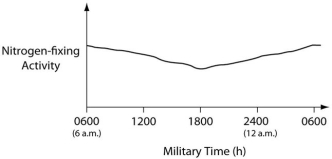Question 79
(Multiple Choice)
For several decades now,amphibian species worldwide have been in decline.A significant proportion of the decline seems to be due to the spread of the chytrid fungus,Batrachochytrium dendrobatidis (Bd).Chytrid sporangia reside within the epidermal cells of infected animals,animals that consequently show areas of sloughed skin.They can also be lethargic,which is expressed through failure to hide and failure to flee.The infection cycle typically takes four to five days,at the end of which zoospores are released from sporangia into the environment.In some amphibian species,mortality rates approach 100%; other species seem able to survive the infection.
-Data were collected from the heterocysts of a nitrogen-fixing cyanobacterium inhabiting equatorial ponds.Study the following graph and choose the most likely explanation for the shape of the curve.

A)Enough O₂ enters heterocysts during hours of peak photosynthesis to have a somewhat-inhibitory effect on nitrogen fixation.
B)Light-dependent reaction rates must be highest between 1800 hours and 0600 hours.
C)Atmospheric N₂ levels increase at night because plants are no longer metabolizing this gas, so they are not absorbing this gas through their stomata.
D)Heterocyst walls become less permeable to N₂ influx during darkness.
E)The amount of fixed nitrogen that is dissolved in the pond water in which the cyanobacteria are growing peaks at the close of the photosynthetic day (1800 hours).
Answer